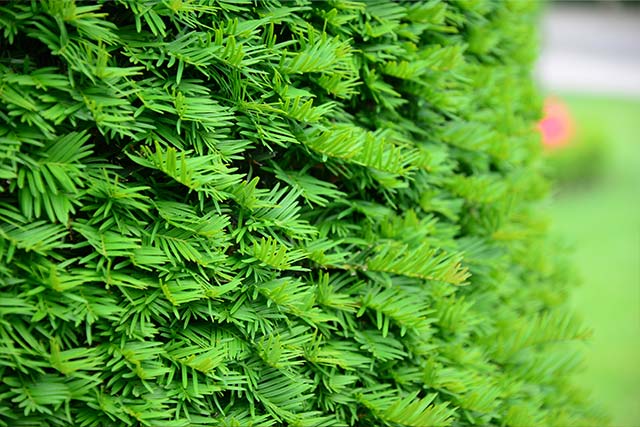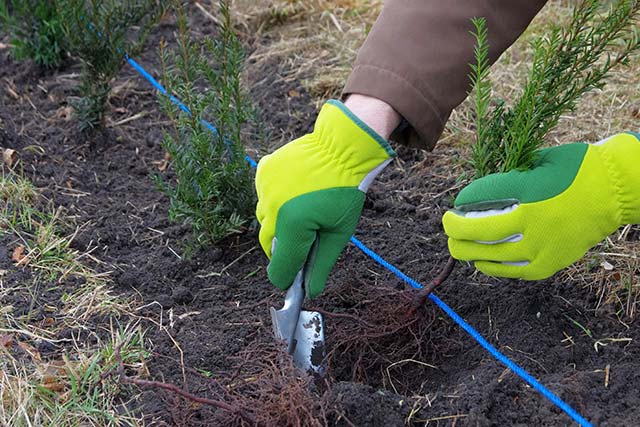Yew Hedging Taxus baccata is a popular, native, evergreen hedging species which ideal for privacy screens, formal hedges and topiary and is a great alternative to Leylandii.
Yew hedging is a versatile hedge, suitable for various purposes such as privacy screens, formal hedges, and topiary. It also has relatively small leaves, making it easy to trim into the desired shape. Yew hedging looks particularly attractive when allowed to grow tall and full, and they can form a stunning backdrop for any garden.
Choose from our most popular varieties of Yew Hedging plants, available in a range of sizes and root types.
English Yew, also known as yew taxus baccata, is a dense evergreen hedging plant with dark green, conifer foliage that is tolerant of being clipped. It is perfect for reducing road noise and providing privacy.
Growth rate: Medium 20-40cm per year
Overall height: Medium up to 5 metres
Position: Full Shade, Full Sun, Exposed, Sheltered
Root Types: Bare Root, Instant Hedging, Pot Grown, Root Balled
Our team are on hand to help answer your questions!
info@hedgingplantsdirect.co.uk
Opening times
Monday - Friday : 7:30am - 4:30pm
Saturday & Sunday: 10am - 2pm
We are also open 10am to 2pm on bank holidays
Yew hedges, or Taxus Baccata as they are scientifically known, are a popular hedging plant in British gardens. This perennial evergreen species is characterised by its vibrant, dark green foliage and distinctive red arils that resemble berries, adding a touch of colour to its deep green backdrop.
One of the key attributes of yew hedge is it’s remarkable adaptability. These plants have the ability to thrive in a variety of soil types and weather conditions, making them a highly versatile choice for gardeners. Yew hedges are available in various forms, including bare root yew plants, which require careful handling to ensure successful growth.
Whether planted in full sun or shade, or in exposed or sheltered positions, yew hedges maintain their lush appearance and robust health.
Yew hedges are known as being slow growing, with an average growth rate of 30cm each year, reaching a height up to 5 metres. This makes yew an excellent choice for any type of formal hedge and topiary applications. The slow growth rate of yew makes it an excellent choice for topiary yew, allowing for precise shaping and maintenance.


For a step by step process and further information on how to plant yew hedges, please see our comprehensive hedge planting guide.
The best times to plant yew hedge is during the autumn and spring months. These periods offer ideal conditions, as the soil is generally moist and temperatures are relatively mild.
Planting during these seasons allows the yew to establish their roots in the new soil before the harsher weather conditions of summer or winter set in.
However, if you opt for pot grown Taxus baccata hedging, they can be planted year-round, offering greater flexibility.
Remember to water your yew hedges regularly, particularly during dry spells, to ensure they establish well and grow into a thick, dense hedge.

The distance between each yew hedge plant depends on the root type and size of the plant.
Please refer to our Yew Hedge spacing chart below which contains the correct planting spacing and distances for each root type and plant size.
Yew hedging plants are versatile and can tolerate a wide range of soil types, whether it's clay, loam, or sandy soil. However, they prefer well-drained soil conditions. While yew can tolerate some waterlogging,
it's crucial to avoid planting them in overly wet conditions to prevent root rot. As for planting positions, yew hedge plants can grow in both full sun and shade. If planted in a sunny spot, they produce more berries and have a denser foliage.
In contrast, if planted in shade, they can still thrive but might produce fewer berries. The flexibility in terms of soil type and planting positions makes english yew hedges a popular choice for diverse landscapes.
Maintaining your yew hedge involves regular pruning and monitoring to ensure its optimal health and aesthetic appeal.
While yew plants can tolerate heavy pruning, it is generally recommended to trim about one-third of the plant’s height annually. Regular pruning will encourage dense growth, resulting in a more solid and full hedge.
The best time to prune a yew hedge is in late summer or early autumn, allowing any cuts to heal before the onset of winter.
As for feeding, an application of a balanced, slow-release fertiliser in early spring can promote vigorous growth.
Ensure your yew hedge receives ample water, especially younger plants during dry spells, but be careful not to overwater as yew plants do not fare well in waterlogged conditions.
Lastly, keep an eye out for any signs of pests or disease, although taxus baccata hedges are typically resistant to most common garden pests. With these measures, your yew hedge will remain healthy and attractive year-round.
Yew hedges are particularly attractive to a variety of birds, who seek shelter in their dense foliage and consume the red arils produced by the plants. However, it should be noted that all parts of the yew plant, with the exception of the arils, are toxic to most mammals.
The growth rate of a yew hedge depends on the specific variety and growing conditions, but most yew hedges grow at a moderate rate of 20-40cm per year. Therefore, it may take several years for a yew hedge to reach its full potential height of up to 5 metres.
All parts of a yew plant, with the exception of the arils, are toxic if ingested. Therefore, they can pose a risk to pets if not properly managed. It's recommended to regularly check and clean the area around a yew hedge to ensure fallen leaves or other parts of the plant are not accessible to pets.